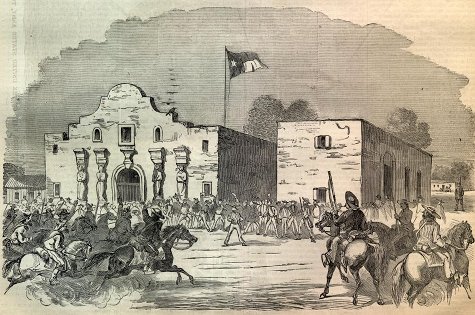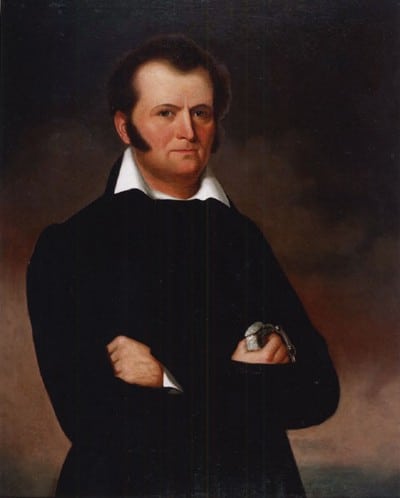
Few men so well embody masculinity as the legendary assembly that stood in defense of the Alamo from February 23 to March 6, 1836. With a cast of characters larger than life itself, the story of the Battle of the Alamo stands out in early American history.The most notable of these men, David Crockett, was a true embodiment of masculinity. His had a full life, filled with bear hunts, expeditions into the unknown, speaking out against government corruption, and eventually giving his life in defense of the freedom he never once took for granted. A near mythical figure in his own time, his legend only continued to grow after his death, and his legacy lives on even today.
Drawing on their own words and the words written about them, we can examine the characteristics that made Crockett and his fellow Alamo defenders legends.
Never compromise your values

Davey Crockett
Crockett was already quite the celebrity by the time he arrived at the Alamo. Always interested in affairs of state, he ran for a seat in the United States House of Representatives and was twice elected to that office. As a Congressman, he was known chiefly for his opposition to the Indian Removal Act. This unfortunate policy was later signed into law in spite of his objections, and his outspokenness is considered the main cause of his defeat in a reelection bid the following year. Following this defeat, Crockett wrote:
I would rather be beaten and be a man than to be elected and be a little puppy dog. I have always supported measures and principles and not men. I have acted fearlessly and independent and I never will regret my course. I would rather be politically buried than to be hypocritically immortalized.
Crockett won his seat back the following election, only to lose it again at the end of the same term, signaling the end of his life in politics. Crockett then set his sights on Texas. Leaving behind his now large family, he went seeking adventure and exploration of unknown lands, hoping to find a place for his family to settle permanently.
In order to legally settle in Texas, Crockett had to take an oath of allegiance and sign on with the Texas militia. Eventually this course led him to the Alamo, where he fought bravely in defense of freedom and his fellow man.
A great man keeps company with great men

Jim Bowie
Arriving at the Alamo, Crockett quickly surrounded himself with invaluable counsel in the form of Colonel William Travis and another American legend, Jim Bowie. Travis, leader of the forces at the Alamo, is remembered for his refusal to surrender in the face of the overwhelming odds presented by the invading Mexican force. Bowie, another prominent frontiersman like Crockett, is especially remembered for the knife which now bears his name. Crockett expressed an interest in the then already legendary blade, noting that the mere sight of the immense weapon was enough to make a man sick before breakfast. Both men had been said to share a mutual respect, and Bowie was glad to have Crockett alongside him, not only for his fighting capabilities, but because of the energy and spirit he raised in the men.
Great men are courageous in the face of adversity

The encounter at the Alamo would soon unfold. Mexican General Santa Anna was marching his men across the Rio Grande with intent to capture all of San Antonio. Doing this would suppress the Texan rebellion and allow Mexico to regain control of the territory. The invasion crossed the path of the Alamo, which was said by General Santa Anna to have “the greatest concentration of cannons west of the Mississippi river.” It was a force he simply could not ignore. On February 23, 1836, Santa Anna arrived at the Alamo, bringing with him numbers reported as high as 5,000, although an estimated 1,400 were actually deployed in the attack. The Mexican forces laid siege to the old mission for thirteen straight days before their final assault. Seeing the bleak chances of success, Colonel Travis sent riders to request assistance from the Texas Government. His last letter, sent as an appeal for reinforcements, emphasizes his steadfast courage:
The enemy has demanded a surrender at discretion, otherwise, the garrison are to be put to the sword, if the fort is taken. I have answered the demand with a cannon shot, and our flag still waves proudly from the walls. I shall never surrender or retreat.
Travis’ request for back-up went unanswered, due mostly to a lack of manpower and poor organization on the part of the Texas Provisional government and the standing Texian army. This left the men at the Alamo, most of who were not even soldiers, to defend their post alone.
Visibly outnumbered, the forces of the Texas rebels held their post for thirteen days before the Mexican army pushed its final assault on March 6. The attack started at 5:00am and by 6:30am it had ended- the small mission now under Mexican control. Jim Bowie, who had been confined to his bed during the battle due to illness, stayed true to his legend, fighting until his last breath. He shot every Mexican soldier that entered through his door until he was out of ammo, upon which event the enemy was so scared to enter that they shot him from the doorway. They then approached his bed, and with his last dying breath he plunged his trademark weapon into the heart of one of the soldiers and fell dead.
Best estimates seem to indicate that all 183 Texians fell at the Alamo, crushed by the overwhelming Mexican force that raided the old mission.
How David Crockett met his untimely end is one of the great mysteries in the record of American history. While it is taken with a degree of certainty that he died defending the Alamo, there is much debate over whether he went out fighting or was captured and executed. One account, from a Colonel in Santa Anna’s Army, states that Crockett was captured with a few remaining others and tortured and executed. Many, however, consider this to be propaganda intentionally spread around by Santa Anna’s men to break the American spirit. Another account, taken from a former American slave who acted as cook for one of Santa Anna’s officers, maintained that Crockett’s body was found in the barracks surrounded by “no less than sixteen Mexican corpses,” with Crockett’s knife buried in one of them. The full account of Crockett’s demise may never be known, and perhaps that is for the better. In his book, Three Roads to the Alamo, William C. Davis writes of Crockett’s end:
His death, like his life, was simply too big to contain within the normal bounds of mortals. In the best heroic fashion of Nimrod Wildfire, Jeremiah Kentucky, Daniel Boone, and a whole generation of Americans searching for a new identity all their own, Davy Crockett, David of the River, Davy of the West, Loco Davy had died everywhere, because he was a host in himself. Besides, his end fitted the life of a legend. For when no one sees a legend die, then the legend lives.


